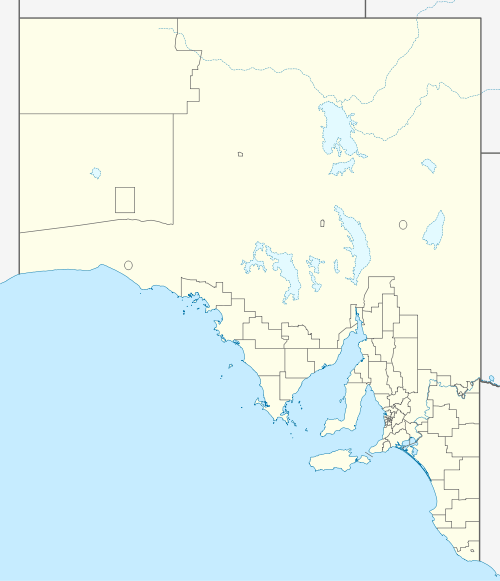Pipalyatjara, South Australia
Pipalyatjara, formerly known as Mount Davies, is an Aboriginal community in the Anangu Pitjantjatjara Yankunytjatjara Lands in South Australia, comprising one of the six main communities on "The Lands" (the others being Amata, Ernabella/Pukatja, Fregon/Kaltjiti, Indulkana and Mimili). At the 2016 Census, Pipalyatjara had a population of 189.[1] The residents are mainly Anangu who speak Pitjantjatjara as their first language.
| Pipalyatjara South Australia | |
|---|---|
 Pipalyatjara | |
| Coordinates | 26°9′46″S 129°10′12″E |
| Population | 189 (2016 census)[1] |
| Postcode(s) | 5710 |
| Elevation | 652 m (2,139 ft) |
| Location | 550 km (342 mi) southwest of Alice Springs |
| LGA(s) | Anangu Pitjantjatjara Yankunytjatjara |
| State electorate(s) | Giles |
| Federal Division(s) | Grey |
Geography
Pipalyatjara is situated approximately 550 kilometres (340 mi) south-west of Alice Springs on the Gunbarrel Highway, an unsealed road.[2] Pipalyatjara is approximately 30 kilometres (19 mi) from the junction of the South Australian, Western Australian and Northern Territory borders (known as the Surveyor-General's Corner).[3]
The community of Kalka is situated some 15 kilometres (9.3 mi) away (by road, on the north side of the mountain ridge to which Pipalyatjara lies to the south).[4] Both communities are located within the Tomkinson Ranges.[2]
Kunytjanu is an outstation and waterhole to the south, serviced from Pipalyatjara. It is located on the road between Pipalyatjara and Watarru.
Climate
As of 2014, based upon the climate records of the nearest weather station, the Giles Weather Station, just across the border and slightly to the northwest in Western Australia, Kalka experiences summer maximum temperatures of an average of 37.2 degrees Celsius in January and a winter maximum average temperature of 19.9 degrees Celsius in July. Overnight lows range from a mean minimum temperature of 23.5 degrees in January to 6.8 degrees in June.[2]
Annual rainfall averages 284.2 millimetres (11.19 in).[2]
East Arnhem Regional Council provides local government in Yirrkala, which is in the Council’s Gumurr Miwatj Ward. 80s==History== Little is known about how the traditional owners and other peoples came to have a settlement at what is now known as Pipalyatjara.
Pipalyatjara was formerly known as Mount Davies, named after the tallest local peak.[4]
The settlement was funded as an outstation during the 1980s.[5]
Chrysoprase was mined at Pipalyatjara until recently.[4]
Facilities
A general store provides for both the Pipalyatjara and Kalka communities.[3]
As of 2007, South Australia Police were based at Murputja, South Australia and running patrols in the area. There was a rudimentary shed structure that serves as a police station when police are present.[6] As of 2020 a new, permanent policing complex is being built at Umawa. It will accommodate officers with specialist response capabilities, as well provide a base for a mobile unit which will be deployed in Fregon/Kaltjiti, Indulkana and Pipalyatjara. The service will work closely with child protection service agencies address child abuse and family violence issues.[7][8] The 2019–2020 Government of South Australia agency budget estimates the completion date as June 2021, with a total spend of A$4.28 million.[9]
Diesel power generation facilities supply power to both Pipalyatjara and Kalka. Water for the power station is supplied by SA Water.[2]
The Pipalyatjara Anangu School serves both Pipalyatjara and Kalka Community.[10][4]
The community-run Ninuku Arts project supports artists from Pipalyatjara and Kalka.[11]
As with most APY settlements, Australian Broadcasting Corporation and Special Broadcasting Service television are available.
There is an unsealed airstrip.[12]
A mobile polling booth visits Pipalyatjara every four years for elections of the Parliament of South Australia.
A permit is required for a member of the public to visit any community on the APY Lands, as they are freehold lands owned by the Aboriginal people.
Footnotes
- "2016 Census QuickStats: Pipalyatjara". Australian Bureau of Statistics. Retrieved 15 March 2020.
- "Part B Attachment 1: Aboriginal Community Sites" (version 2.2 ed.). Government of South Australia. Department of State Development (DSD). March 2014. Retrieved 15 March 2020. Cite journal requires
|journal=(help) - "Pipalyatjara". Pitjantjatjara Yankunytjatjara Media. Retrieved 15 March 2020.
- "Our Communities". Pipalyatjara Community School website. Archived from the original on 5 October 2009.
- Parliament of Australia. House of Representatives Standing Committee on Aboriginal Affairs; Blanchard, Allen (March 1987). "Inquiry into the Aboriginal homelands movement in Australia". Parliament of Australia. Published online 12 June 2011. ISBN 0 644 06201 0. Retrieved 16 August 2020. PDF
- SA Police Association Newsletter
- Henson, Elizabeth (17 October 2018). "New police complex at Umuwa and mobile pop-up station in $4.28 million APY Lands project". The Advertiser. Retrieved 7 July 2019.
- "Enhanced police service delivery on APY Lands". Australian Government. Dept of Prime Minister and Cabinet. Retrieved 7 July 2019.
- State Budget 2019–20: Agency Statement: Budget Paper 4, Volume 3 (PDF) (Report). Government of South Australia. Dept of Treasury and Finance. 18 June 2019. ISSN 1440-8589. Retrieved 16 January 2020.
- "Pipalyatjara Anangu School". Pipalyatjara Anangu School. Government of South Australia. Department of Education and Children's Services. 24 August 2009. Retrieved 15 March 2020.
- Ninuku Arts
- "Civil Works". RASAC - Regional Anangu Services Aboriginal Corporation. Retrieved 15 March 2020.
Further reading
- "Operation Desert Stormwater Harvesting" (PDF). Indigenous Centre for Appropriate Technology "Bush Brief" #3. Archived from the original (PDF) on 12 August 2007.
External links
- "Pipalyatjara". Google Maps.